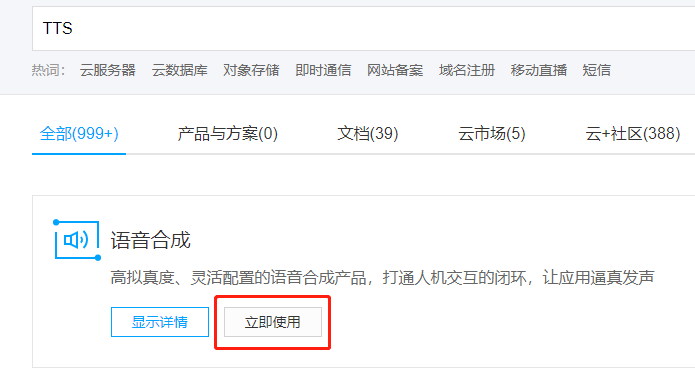任务 2 创建云函数调用TTS接口
任务目的
小程序调用TTS接口,可以使用云函数来实现。云函数是一段运行在云端的代码,无需管理服务器,在开发工具内编写、一键上传部署即可运行后端代码。本实验先完成TTS接口的调用。
任务步骤
1.开通TTS接口
在腾讯云官网搜索“TTS”,搜索结果会出现【语音合成】,点击【立即使用】按钮。
在语音合成界面勾选“我已阅读并同意《用户协议》”,点击【免费试用】按钮,即可开通TTS接口。
在后面会使用小程序调用各种接口,这里需要先记录腾讯云账号的APPID,SecretId,SecretKey。
在官网点击右上角账号图标进入【账号中心】
在【账号信息】界面记录下APPID,然后点击【访问管理】
在【访问管理】界面点击【访问密钥】下的【API密钥管理】,可以看到账号的SecretId和SecretKey,SecretKey需要扫码验证身份后才可以显示。记录下SecretId和SecretKey,后续小程序调用TTS接口会使用。
2.创建云函数
在创建云开发项目时,微信开发者工具会在 cloudfunctions 文件夹下自动生成四个本地的云函数,这四个云函数与本项目无关,因此先将这四个云函数所在的文件夹删除。分别在四个文件夹上右击,选择删除。注意:在微信开发者工具内只能分多次删除,不能一次性删除。
然后右键点击cloudfunctions文件夹,选择【新建 Node.js 云函数】
填写云函数名字,这里命名为“invokeTTS”。
函数创建完成后包含 index.js 和 package.json 两个文件。
3.编写云函数
首先添加云函数所需依赖,这里需要添加腾讯云sdk的依赖。点击 package.json,在“dependencies”下,添加语句
"tencentcloud-sdk-nodejs": "latest"注意:dependencies中每个依赖间用“,”隔开,最后一个依赖后,不能有“,”,如果缺少或者多添加“,”,微信开发者工具会报错。
点击 index.js ,将 index.js 改写成以下代码。
// 云函数入口文件
const cloud = require('wx-server-sdk')
cloud.init()
//引入腾讯云sdk的依赖
const tencentcloud = require("tencentcloud-sdk-nodejs");
//设置成自己的secretId,secreteKey
const secretId = "yourSecretId" # 用户的 SecretId,建议使用子账号密钥,授权遵循最小权限指引,降低使用风险。子账号密钥获取可参考https://cloud.tencent.com/document/product/598/37140
const secretKey = "yourSecretKey" # 用户的 SecretKey,建议使用子账号密钥,授权遵循最小权限指引,降低使用风险。子账号密钥获取可参考https://cloud.tencent.com/document/product/598/37140
//调用TTS接口
function invokeTTS(transObj) {
const TtsClient = tencentcloud.tts.v20190823.Client;
const models = tencentcloud.tts.v20190823.Models;
const Credential = tencentcloud.common.Credential;
const ClientProfile = tencentcloud.common.ClientProfile;
const HttpProfile = tencentcloud.common.HttpProfile;
let cred = new Credential(secretId, secretKey); # 用户的 SecretId,建议使用子账号密钥,授权遵循最小权限指引,降低使用风险。子账号密钥获取可参考https://cloud.tencent.com/document/product/598/37140
# 用户的 SecretKey,建议使用子账号密钥,授权遵循最小权限指引,降低使用风险。子账号密钥获取可参考https://cloud.tencent.com/document/product/598/37140
let httpProfile = new HttpProfile();
httpProfile.endpoint = "tts.tencentcloudapi.com";
let clientProfile = new ClientProfile();
clientProfile.httpProfile = httpProfile;
let client = new TtsClient(cred, "ap-guangzhou", clientProfile);
let req = new models.TextToVoiceRequest();
let params = `{"Text":"${transObj.content}","SessionId":"session-1","ModelType":1,"VoiceType":"${transObj.voiceType}","Codec":"mp3"}`
req.from_json_string(params);
return new Promise((resolve, reject) => {
client.TextToVoice(req, function (errMsg, response) {
if (errMsg) {
console.log(errMsg);
reject(errMsg)
}
resolve(response)
})
}).then((res) => {
return res.Audio
})
}
// 云函数入口函数
exports.main = async (event, context) => {
return invokeTTS(event.transObj)
}改写后的 index.js 引入了腾讯云sdk的依赖,并设置自己账号的secretId与secretKey。
//引入腾讯云sdk的依赖
const tencentcloud = require("tencentcloud-sdk-nodejs");
//设置成自己的secretId,secreteKey
const secretId = "yourSecretId" # 用户的 SecretId,建议使用子账号密钥,授权遵循最小权限指引,降低使用风险。子账号密钥获取可参考https://cloud.tencent.com/document/product/598/37140
const secretKey = "yourSecretKey"# 用户的 SecretKey,建议使用子账号密钥,授权遵循最小权限指引,降低使用风险。子账号密钥获取可参考https://cloud.tencent.com/document/product/598/37140编写一个invokeTTS的函数调用TTS接口。这里 invokeTTS 函数接受一个 transObj 对象作为参数,这个参数中需要包含 content 属性和 voiceType 属性,content 属性代表合成语音的内容,voiceType 属性代表合成语音的类型。完整版本如下。
//调用TTS接口
function invokeTTS(transObj) {
const TtsClient = tencentcloud.tts.v20190823.Client;
const models = tencentcloud.tts.v20190823.Models;
const Credential = tencentcloud.common.Credential;
const ClientProfile = tencentcloud.common.ClientProfile;
const HttpProfile = tencentcloud.common.HttpProfile;
let cred = new Credential(secretId, secretKey); # 用户的 SecretId,建议使用子账号密钥,授权遵循最小权限指引,降低使用风险。子账号密钥获取可参考https://cloud.tencent.com/document/product/598/37140
# 用户的 SecretKey,建议使用子账号密钥,授权遵循最小权限指引,降低使用风险。子账号密钥获取可参考https://cloud.tencent.com/document/product/598/37140
let httpProfile = new HttpProfile();
let httpProfile = new HttpProfile();
httpProfile.endpoint = "tts.tencentcloudapi.com";
let clientProfile = new ClientProfile();
clientProfile.httpProfile = httpProfile;
let client = new TtsClient(cred, "ap-guangzhou", clientProfile);
let req = new models.TextToVoiceRequest();
let params = `{"Text":"${transObj.content}","SessionId":"session-1","ModelType":1,"VoiceType":"${transObj.voiceType}","Codec":"mp3"}`
req.from_json_string(params);
return new Promise((resolve, reject) => {
client.TextToVoice(req, function (errMsg, response) {
if (errMsg) {
console.log(errMsg);
reject(errMsg)
}
resolve(response)
})
}).then((res) => {
return res.Audio
})
}在函数中首先引入腾讯云sdk的相关类
const TtsClient = tencentcloud.tts.v20190823.Client;
const models = tencentcloud.tts.v20190823.Models;
const Credential = tencentcloud.common.Credential;
const ClientProfile = tencentcloud.common.ClientProfile;
const HttpProfile = tencentcloud.common.HttpProfile;然后创建相关类的对象,这里注意创建 Credential 类的对象需要 secretId 与 secretKey 作为参数。
本实验调用TTS接口所需参数如下表所示。
参数名称 | 必选 | 类型 | 描述 |
|---|---|---|---|
Region | 是 | String |  |
Text | 是 | String | 合成语音的源文本,按UTF-8编码统一计算 |
SessionId | 是 | String | 一次请求对应一个SessionId,会原样返回,建议传入类似于uuid的字符串防止重复。 |
ModelType | 是 | Integer | 模型类型,1-默认模型。 |
VoiceType | 否 | Integer | 音色 |
Codec | 否 | String | 返回音频格式,可取值:wav(默认),mp3 |
调用接口的返回值如下表所示
参数名称 | 类型 | 描述 |
|---|---|---|
Audio | String | base64编码的wav/mp3音频数据 |
SessionId | String | 一次请求对应一个SessionId |
RequestId | String | 唯一请求 ID,每次请求都会返回。定位问题时需要提供该次请求的 RequestId。 |
更多关于TTS接口的详细描述,可进入腾讯云API中心的语音合成页面做进一步的了解。
let cred = new Credential(secretId, secretKey); # 用户的 SecretId,建议使用子账号密钥,授权遵循最小权限指引,降低使用风险。子账号密钥获取可参考https://cloud.tencent.com/document/product/598/37140
# 用户的 SecretKey,建议使用子账号密钥,授权遵循最小权限指引,降低使用风险。子账号密钥获取可参考https://cloud.tencent.com/document/product/598/37140
let httpProfile = new HttpProfile();
httpProfile.endpoint = "tts.tencentcloudapi.com";
let clientProfile = new ClientProfile();
clientProfile.httpProfile = httpProfile;
let client = new TtsClient(cred, "ap-guangzhou", clientProfile);
let req = new models.TextToVoiceRequest();
let params = `{"Text":"${transObj.content}","SessionId":"session-1","ModelType":1,"VoiceType":"${transObj.voiceType}","Codec":"mp3"}`
req.from_json_string(params);最后调用 client 对象的 TextToVoice 方法,传入 req 对象和回调函数即可。
new Promise((resolve, reject) => {
client.TextToVoice(req, function (errMsg, response) {
if (errMsg) {
console.log(errMsg);
reject(errMsg)
}
resolve(response)
})
}).then((res) => {
return res.Audio
})注意:这里使用Promise语法异步返回调用结果,可以采用其他异步调用的写法,但不能使用同步调用。
最后在云函数的入口函数直接调用invokeTTS,传入相应参数即可。
// 云函数入口函数
exports.main = async (event, context) => {
return invokeTTS(event.transObj)
}4.测试云函数
先将写好的云函数上传云端,在编写的云函数上点击右键选择【上传并部署:云端安装依赖(不上传 node_modules)】的按钮
开始上传时,微信开发者工具会显示
此时云函数上传至云端,但并没有完成,等待一段时间后显示
此时说明上传云函数完成,可以开始测试。点击【云开发】按钮,进入云开发控制台,点击【云函数】按钮,会在云函数列表中看到刚才编写的云函数,点击后面的【云端测试】按钮,进入云端测试页面。
测试云函数时已经内置了一些常用的测试模板,可以改写测试模板,也可以直接新建一个模板,为了方便后续的调用,这里选择新建模板。
将模板命名为testTTS,参数写法如下。
{
"transObj":{
"content":"测试TTS接口",
"voiceType":1
}
}测试使用的实参相当于云函数中的 event 形参,在云函数调用invokeTTS 时,传入 event.transObj 就可传入到符合要求的参数
exports.main = async (event, context) => {
return invokeTTS(event.transObj)
}点击【确定】,然后点击【测试运行】
运行测试后,可以看到【调用状态】为成功,【返回结果】是一个很长的字符串。这里的返回结果代表被Base64编码的mp3音频数据,使用Base64编码是为了方便音频在网络上传输。返回结果不能直接使用,需要使用Base64解码才能使用。解码过程会在后面讲到,现阶段只要看到返回Base64编码的字符串即可说明调用成功。
学员评价